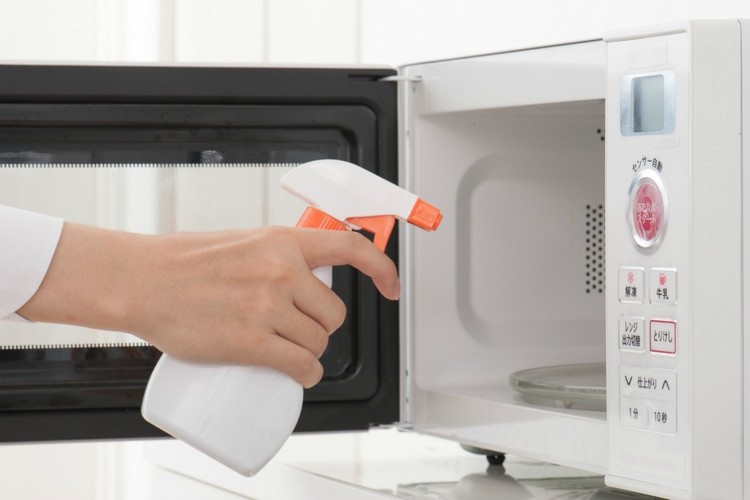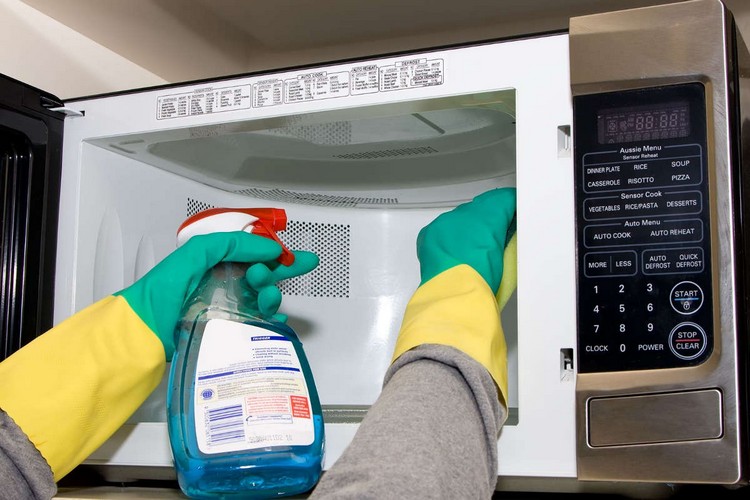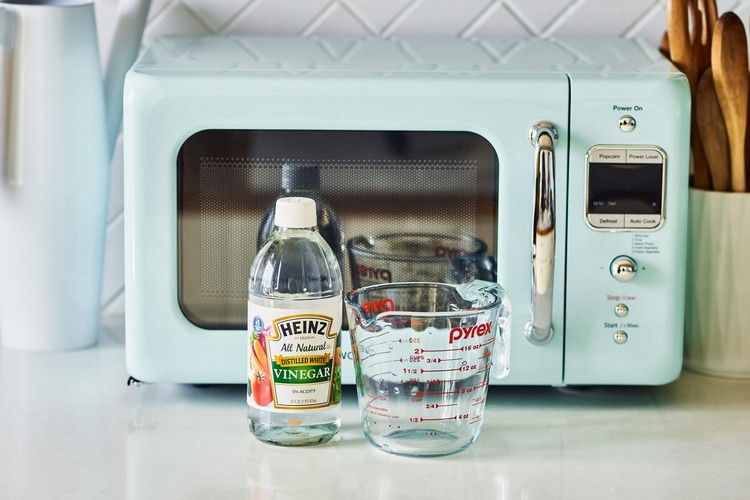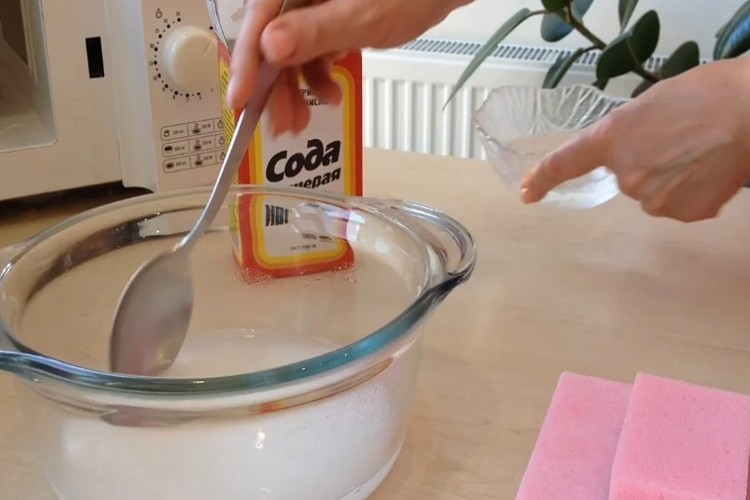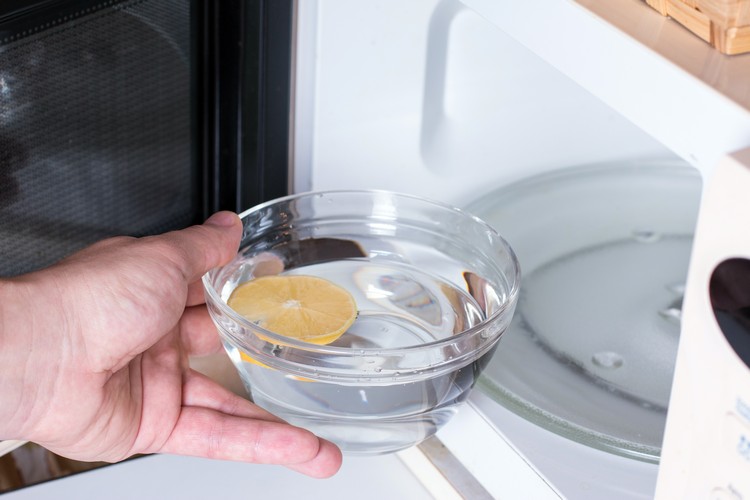Tips on how to wash the microwave from fat inside and out: an overview of cleaning tools and methods
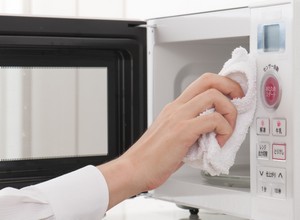 The microwave oven is a really handy appliance in the kitchen.
The microwave oven is a really handy appliance in the kitchen.
But she has one significant drawback: over time, spots necessarily form on the walls of the inner chamber..
This happens even if the microwave is used exclusively for heating food or defrosting convenience foods.
And it can be extremely difficult to wash it, especially if the chamber is made of stainless steel without any coating.
But in practice, there are several recommendations that will allow you to deal with even the most persistent stains in just 10 to 15 minutes.
Content
How to prepare your microwave for cleaning
Immediately before cleaning the inner chamber, you must:
- Disconnect the appliance from the mains.
- Remove the tray from the microwave.
You should also check if the microwave oven supports the self-cleaning function. This information must be indicated in the technical instructions.
How to wash fat
The most “difficult” stains are from old fat dried to the walls.
You can get rid of them with:
- special detergents directly for microwave ovens;
- cleaners for stoves and frying pans;
- cleaning products to remove greasy stains ("anti-grease");
- window cleaners.
Microwave cleaners
In stores, you can find on sale a detergent specifically for a microwave oven.For example, such concerns are produced by Green and Clean, Sano and many others.
Their key difference is that they also remove unpleasant odors, but do not damage the surface of the inner chamber (even if it is bioceramic or acrylic).
Cleaning products for stoves and pans
Immediately it should be noted that they are of two types:
- With abrasive ingredients. Mostly these are powders for stoves. They are not recommended for cleaning microwave ovens, as they can scratch the coating of the inner chamber of the microwave oven. This will certainly lead to the formation of corrosion, and it will be difficult to remove rust and repair the surface.
- No abrasive ingredients. As a rule, these are gels that must first be sprayed or applied with a dry sponge. Indeed, they allow you to get rid of even the most persistent greasy stains, but they do not always help to remove an unpleasant odor.
Fat removers
Mainly used for "restoration" of old frying pans.
They do an excellent job with grease, but it is recommended to test before use: apply a small amount of detergent to an inconspicuous area of \u200b\u200bthe microwave (near the back wall or below). This is necessary to make sure that the gel does not harm the enamel, that is, there are no “aggressive” components in the composition.
Window cleaner
It is an alternative to specialized microwave oven cleaners.
There are no abrasive components in the composition of such liquids, so it is almost impossible to damage the coating of the inner chamber. At the same time, the composition contains alcohol (ethanol) - it perfectly removes unpleasant odors.
It is enough to spray it on the inner chamber, hold it for 5-10 minutes, and then wipe it with a dry cloth (even better - microfiber). But with persistent stains, this option will not help to cope.
Handy tools for cleaning microwave ovens
In any kitchen there are a lot of tools with which you can clean even the dirtiest microwave oven. It is not necessary to use special cleaning gels and solutions for this.
Experienced housewives recommend removing grease stains and unpleasant odors with:
- vinegar;
- hydrogen peroxide;
- citric acid solution;
- orange or lemon peels;
- soda.
Vinegar
The main advantage of vinegar: it helps to get rid of not only stubborn grease stains, but also oxide deposits on the inner walls of the microwave oven.
Should be used like this:
- mix in a separate bowl 3 tablespoons of vinegar and 0.5 cups of water;
- put the bowl in the microwave;
- turn on the maximum heating of the microwave for 5 - 10 minutes.
After 5-10 minutes, the microwave should be turned off, disconnected from the mains, remove the dishes from it and wipe the walls of the inner chamber with a sponge and dishwashing detergent.Vinegar not only does an excellent job with grease stains, but also easily removes unpleasant and pungent odors (for example, after cooking meat dishes using a lot of spices).
Hydrogen peroxide
Hydrogen peroxide breaks down fat very well.
How to clean your microwave oven:
- for 0.5 cups of water, add 1 teaspoon of dish detergent and 1 tablespoon of hydrogen peroxide;
- mix all this thoroughly until foam is formed;
- apply with a sponge on the inner walls of the microwave oven, leave for 2 - 3 minutes;
- moisten a rag or sponge in hydrogen peroxide - wipe off the remnants of the solution.
If necessary, repeat the procedure. Similarly, you can clean the microwave oven door, as well as remove traces of yellowness on the body itself.
Citric acid solution
Removes grease and odor well.
To prepare the solution, you need to mix 0.5 cups of warm water and 2 - 3 teaspoons of citric acid. Stir thoroughly until all crystals are completely dissolved (otherwise they will work as an abrasive component, that is, you can scratch the coating). Apply with a sponge to the surface of the inner chamber of the microwave, and after 2 minutes - clean with a damp cloth.
Cleaning with a solution of citric acid should not be carried out if the material of the inner chamber is stainless steel (and "heat-resistant" too, they are the same material) or acrylic.
Orange or lemon peels
They clean in the same way as a citric acid solution (they have the same cleaning component). But if you believe the reviews, then with the "old" fat spots, this method will not allow you to improve. But you can use it as an alternative for regular cleaning of the microwave.Orange peels also work well and quickly remove the smell from spices.
If the microwave oven is not going to be used for a long time, then the walls of the inner chamber can also be treated with lemon peels to store it. This will prevent the formation of mold and mildew.
Soda
Baking soda is effective against greasy stains, but must be used with care. It is not worth preparing the “gruel” and rubbing the walls of the inner chamber with it - micro-scratches are necessarily formed. It is much more efficient to prepare an aqueous solution and “steam” the microwave with it.
Step by step it looks like this:
- Add 1-2 drops of dishwashing detergent to 0.5 cup of water. More is not needed, as there will be too much foam.
- Add 2 teaspoons of soda, mix the solution thoroughly.
- Place the solution in the microwave, and also put a wooden spoon or spatula in the dishes (to prevent overheating of the dishes).
- Turn on the microwave at maximum power for 5 minutes.
- After - wipe the walls with a soft damp sponge. After removing the formed plaque, it is enough to wash the microwave with dishwashing detergent. This advice is especially useful when “fighting” with burnt food.
Steam cleaning
This is the most "environmentally friendly" and safest option. It is also recommended for those who are allergic to many cleaning products.
Cleaning is done as follows:
- pour about 150 milliliters of water into a glass bowl, place a wooden spoon or spatula there;
- put the bowl in the microwave, turn on the heat at maximum power;
- after 5 minutes - turn off, disconnect from the mains;
- carefully remove the bowl, as well as the stand-tray, wipe the walls with a dry cloth.
To get rid of particularly resistant stains, the procedure can be repeated 2-3 times. The only drawback of this method is that it does not allow you to remove the unpleasant odor.
It should also be noted that some microwaves even have a special “Auto Clean” mode. It works on the same principle, but convection can be additionally turned on (with the help of a fan, steam is blown more strongly through the inner chamber).
How to get rid of bad smell in the microwave
An unpleasant odor is bound to occur with regular use of the microwave oven.
Most often this happens due to:
- Cooking meat dishes using a large number of spices.
- Burning of dishes (when they fall on the inner walls or under a rotating tray plate).
- Grease stain formation.
- Irregular use of the microwave oven.
The easiest way to remove an unpleasant smell is with the help of natural coffee. It is enough to boil it (1 teaspoon per 1 glass of water), let it cool, and then rub the inner walls with it. After 5 minutes, rinse with dishwashing detergent and water.
No less effective is a solution with the addition of activated carbon. For 50 milliliters of water, add about 4 - 5 tablets, mix everything thoroughly. Apply for 10 minutes, then remove with a damp cloth or sponge.
Some microwave ovens have a built-in odor removal function. It is carried out due to powerful blowing by the built-in fan (with the door open). But in practice, this does not always help.
You can also get rid of third-party aromas:
- orange peels;
- vinegar (steaming).
Pollution Prevention
While it doesn't take long to clean your microwave oven at home, it's possible to prevent stains from forming.
It is recommended to use the following tips:
- When heating food, defrosting or cooking, cover the plate with a special dome lid. Sold in kitchenware stores. Manufactured from special heat-resistant food-grade plastic. But this option is not suitable, for example, when using a grill.
- After each use, wipe the walls of the inner chamber of the microwave with a damp cloth, without the use of detergents. The heated fat is removed immediately.
- If the oven is rarely used, then at least once a week wipe it from the inside with orange peels. They do not allow mold to form, prevent corrosion, and also remove unpleasant odors.
By the way, manufacturers in the instructions supplied with microwave ovens recommend cleaning after each cooking or heating food. Even if you just decided to peel the tomatoes! But it is unlikely that someone will monitor the kitchen appliance so carefully.
Microwave Cleaning Precautions
When cleaning the microwave, be sure to follow the following rules:
- Do not use metal tools for cleaning. Here you should also add "brushes". This will necessarily lead to the formation of micro-scratches, in places of which corrosion will begin to appear. And bioceramics from such a “care” simply cracks.
- Do not use detergents containing chlorine and its derivatives. Be sure to check the ingredients first!
- There are places that require partial disassembly of the microwave oven to clean. Doing it yourself is downright dangerous. There are powerful capacitors inside the microwave oven. So even if the equipment is disconnected from the mains, this does not mean that it will not be able to "hit" the current.
- To remove crumbs from hard-to-reach places, you can use the most ordinary or car vacuum cleaner.
In total, there are many ways to clean the microwave. The best option is to use specialized tools for microwave ovens. They do not contain chlorine, abrasive components, they do not corrode enamel, do not damage ceramics or acrylic. And they don't cost more than dishwashing detergent. The cleaning itself is recommended to be performed at least once every 2 weeks, as well as after cooking meat dishes.
Useful video
How to wash the microwave with citric acid will tell in the video:



